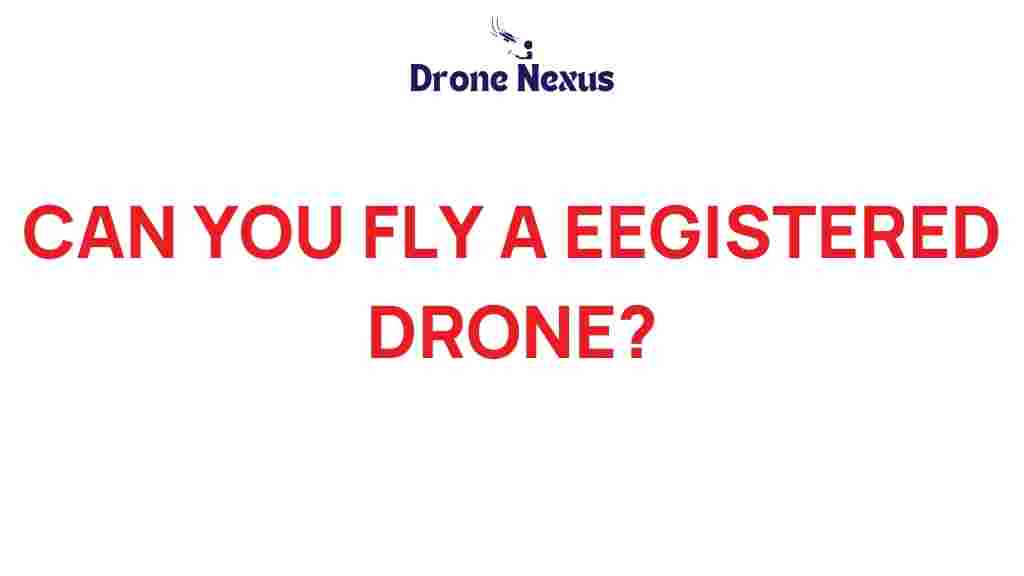The Surprising Truth: Can You Fly a Registered Drone?
As drone technology continues to evolve, many enthusiasts and professionals alike are eager to explore the skies. However, a common question arises: can you fly a registered drone? Understanding the rules and regulations surrounding registered drones is crucial for a safe and enjoyable flying experience. In this article, we will explore the ins and outs of flying a registered drone, including registration requirements, necessary precautions, and some tips to optimize your flying experience.
Understanding Drone Registration
Before delving into whether you can fly a registered drone, it’s important to understand the concept of drone registration itself. In many countries, including the United States, the Federal Aviation Administration (FAA) requires drone owners to register their unmanned aircraft systems (UAS) if they weigh more than 0.55 pounds (250 grams).
- Why Register? Registration helps ensure accountability and safety in the airspace. It provides a way for authorities to track drone owners in case of any incidents.
- How to Register: In the U.S., registration can be completed online through the FAA’s website and costs $5.
- Registration Duration: Once registered, a drone remains registered for three years.
Can You Fly a Registered Drone? The Basics
The short answer is yes, you can fly a registered drone. However, there are specific rules and regulations you must adhere to in order to do so legally and safely.
FAA Regulations for Flying a Registered Drone
When flying a registered drone, it’s essential to comply with the following FAA regulations:
- Altitude Limits: Fly below 400 feet in uncontrolled airspace and stay below 200 feet in controlled airspace.
- Line of Sight: Always maintain visual line of sight with your drone during flight.
- Restricted Areas: Avoid flying near airports, crowds, and other restricted areas. Use apps like B4UFLY to check airspace restrictions.
- Night Flying: Flying at night is allowed, but your drone must have proper lighting for visibility.
Step-by-Step Process to Fly a Registered Drone
Now that you know the basic regulations, let’s go through a step-by-step process on how to prepare for your drone flight.
1. Check Registration Status
Before flying, verify that your drone is registered. You can do this by visiting the FAA’s registration site and entering your details.
2. Pre-Flight Checklist
Ensure your drone is in good working condition:
- Check battery levels.
- Inspect propellers for damage.
- Update firmware if necessary.
- Ensure your remote control is functioning properly.
3. Choose a Safe Location
Select a place away from people, buildings, and crowded areas. Open fields or designated flying areas are ideal.
4. Understand Local Laws
In addition to FAA rules, familiarize yourself with local laws regarding drone flying. Some municipalities have specific regulations that may affect where and how you can fly.
5. Perform a Test Flight
Before going for a full flight, conduct a short test flight to ensure everything is functioning properly.
Troubleshooting Tips for Flying a Registered Drone
Even experienced pilots can face challenges while flying a registered drone. Here are some troubleshooting tips:
- Lost Signal: If you lose signal with your drone, activate the return-to-home feature if available. Always fly within range.
- Battery Issues: Monitor battery levels closely. Land your drone when the battery reaches 20% to avoid crashes.
- GPS Malfunctions: If GPS is unstable, avoid flying until the issue resolves. Ensure you are in an open area with a clear view of the sky.
Conclusion: The Future of Registered Drones
In conclusion, flying a registered drone is not only possible but also a rewarding experience when done legally and safely. By understanding the regulations, following the necessary steps, and being prepared for potential issues, you can enjoy the skies responsibly. As technology advances and the popularity of drones continues to grow, staying informed about changes in regulations will ensure that you are always in compliance.
For more information on drone regulations, check out the official FAA website. If you’re interested in learning more about different types of drones, visit our drones category for additional resources and guides.
So, are you ready to take your registered drone to the skies? Happy flying!
This article is in the category Safety and created by DroneNexus Team
